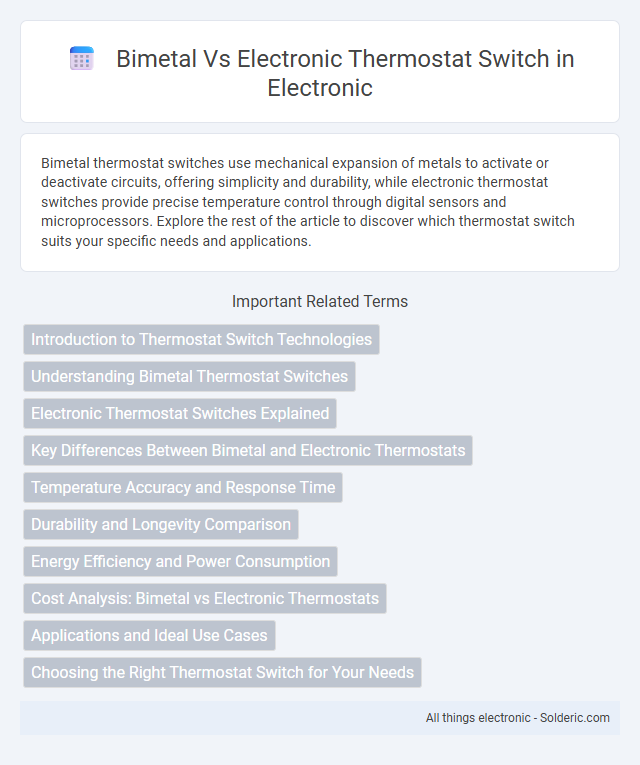Bimetal thermostat switches use mechanical expansion of metals to activate or deactivate circuits, offering simplicity and durability, while electronic thermostat switches provide precise temperature control through digital sensors and microprocessors. Explore the rest of the article to discover which thermostat switch suits your specific needs and applications.
Comparison Table
| Feature | Bimetal Thermostat Switch | Electronic Thermostat Switch |
|---|---|---|
| Working Principle | Mechanical bending of bimetal strip with temperature changes | Electronic sensors measure temperature and control switching |
| Accuracy | Moderate (+-2-5degC) | High (+-0.1-0.5degC) |
| Response Time | Slower due to mechanical movement | Faster electronic response |
| Durability | Robust, less sensitive to electrical noise | Depends on electronic components, may degrade over time |
| Temperature Range | Limited (-40degC to 150degC) | Wide (-100degC to 300degC+) |
| Cost | Low cost, economical | Higher cost due to complex components |
| Size | Bulkier mechanical design | Compact and lightweight |
| Adjustability | Manual, limited precision adjustment | Programmable and precise temperature settings |
| Applications | Household appliances, HVAC, simple controls | Advanced HVAC, industrial automation, smart devices |
Introduction to Thermostat Switch Technologies
Bimetal thermostat switches operate using two metals with differing expansion rates that bend and trigger the switch in response to temperature changes, offering reliable mechanical control without the need for power. Electronic thermostat switches rely on sensors and integrated circuits to detect temperature variations, providing higher precision and programmable settings for diverse applications. These contrasting technologies define the primary mechanisms for temperature regulation in HVAC systems, appliances, and industrial equipment.
Understanding Bimetal Thermostat Switches
Bimetal thermostat switches operate using two metals with different expansion rates laminated together, causing the strip to bend and open or close the electrical circuit as temperature changes. These switches provide reliable mechanical operation without requiring an external power source and are commonly used in heating and cooling systems for precise temperature control. Their simple design ensures durability and cost-effectiveness compared to electronic thermostat switches, which rely on sensors and microprocessors.
Electronic Thermostat Switches Explained
Electronic thermostat switches utilize advanced sensors and microprocessors to provide precise temperature control, enhancing energy efficiency and system reliability. Unlike bimetal thermostat switches, which rely on mechanical bending of metal strips to trigger switching, electronic thermostats offer programmable settings and faster response times. This technology supports seamless integration with smart home systems, enabling remote monitoring and customization for optimal climate management.
Key Differences Between Bimetal and Electronic Thermostats
Bimetal thermostats rely on a physical strip of two bonded metals that expand and contract with temperature changes to open or close a switch, providing a simple and reliable mechanism for temperature control. Electronic thermostats use sensors and microcontrollers to monitor temperature more precisely, offering programmable settings and energy-saving features. Your choice depends on the need for accuracy, programmability, and the type of application, as electronic thermostats generally offer superior control and versatility compared to the straightforward operation of bimetal models.
Temperature Accuracy and Response Time
Bimetal thermostat switches typically have lower temperature accuracy, with variations of +-3 to +-5degC due to mechanical limitations, and slower response times because they rely on the physical bending of a metal strip. Electronic thermostat switches offer higher precision, achieving temperature accuracy within +-0.1 to +-0.5degC, and faster response times by using digital sensors and microcontroller-based control systems. This superior performance makes electronic thermostats ideal for applications requiring precise temperature regulation and rapid adjustments.
Durability and Longevity Comparison
Bimetal thermostat switches offer exceptional durability due to their simple mechanical design and resistance to electrical surges, often lasting over 10 years under normal operating conditions. Electronic thermostat switches provide more precise temperature control but may have a shorter lifespan, typically around 5 to 7 years, due to their reliance on sensitive electronic components. Your choice will depend on whether you prioritize long-term reliability or advanced functionality in temperature management.
Energy Efficiency and Power Consumption
Bimetal thermostat switches rely on physical metal expansion to regulate temperature, resulting in slower response times and less precise control, which can lead to higher energy consumption during heating or cooling cycles. Electronic thermostat switches use sensors and microprocessors to provide accurate temperature readings and quicker adjustments, significantly improving energy efficiency by minimizing temperature fluctuations and reducing power usage. Studies show electronic thermostats can decrease energy consumption by up to 15% compared to bimetal models, making them a preferable choice for energy-conscious applications.
Cost Analysis: Bimetal vs Electronic Thermostats
Bimetal thermostats generally offer a lower upfront cost compared to electronic thermostats, making them an economical choice for basic temperature control needs. Electronic thermostats, while pricier initially, provide enhanced precision, programmability, and energy-saving features that can reduce long-term operational expenses. Evaluating your budget alongside potential energy savings will help determine which thermostat switch delivers the best overall cost efficiency for your specific application.
Applications and Ideal Use Cases
Bimetal thermostat switches are ideal for simple temperature control applications such as household appliances, heaters, and HVAC systems due to their durability and cost-effectiveness. Electronic thermostat switches offer precise temperature regulation, making them suitable for advanced systems in industrial automation, refrigeration, and smart home technology. For environments requiring fast response and accurate temperature settings, electronic switches outperform bimetal models, which are better suited for basic, rugged applications.
Choosing the Right Thermostat Switch for Your Needs
Bimetal thermostat switches offer reliable mechanical temperature control through the expansion and contraction of metal strips, making them ideal for simple, cost-effective applications with moderate precision requirements. Electronic thermostat switches provide higher accuracy and programmable settings by using sensor technology and microcontrollers, suitable for complex systems demanding precise temperature regulation. When choosing the right thermostat switch for your needs, consider the level of control, budget, and the specific environmental conditions where your device will operate.
bimetal vs electronic thermostat switch Infographic

 solderic.com
solderic.com